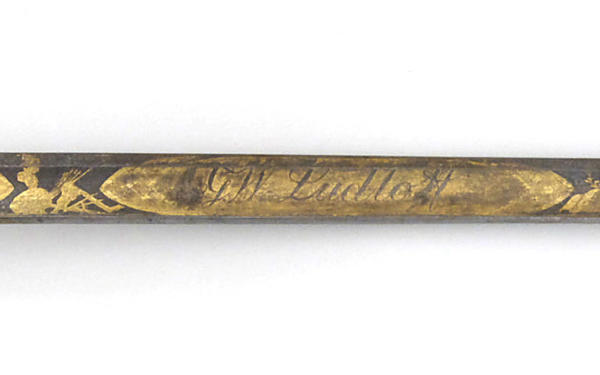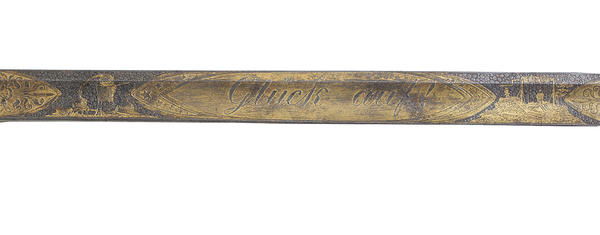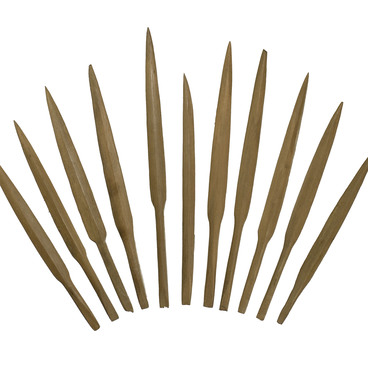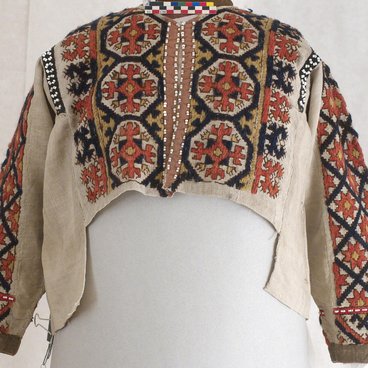The small sword with a gold blade belonged to mining engineer Vassily Ludlov. It was made at the end of the 1810s – beginning of the 1820s in the Urals. Historians suppose that this was an early work by famous Russian blade smith Ivan Bushuyev. This is revealed in the specificity of the composition and the engraving on metal technique. The blade of the small sword is made from steel and the component parts are brass-cast.
Small sword of mining officer V.F. Ludlov
Creation period
End of the 1810s –beginning of the 1820s
Dimensions
75,7x2 cm
75.5х2 cm
75.5х2 cm
Technique
Forging, engraving, gold plating on steel, brass
Exhibition
1
Open in app#6
The Zlatoust Arms Works
Small sword of mining officer V.F. Ludlov
#7
#8
The maker applied engraving on both sides of the knife heel. The knife heel denotes blunt sides of the blade which abut to the hilt. One side bears the engraved name of the owner in German – ‘G.W. Ludloff’.
#9
Engraving ‘G.W. Ludloff “on the handle of a sword
#10
And the other – “Glück auf!” This is an old greeting of German miners that is how they greeted each other when they returned from the mine.
#11
Engraving “Glück auf!” on the handle of a sword
#12
The blade bears the engraved symbols of the mining industry and the engineer’s instruments: mallets, a globe, a sextant, and a cornue.
#13
Engraving symbols of the mining industry and engineering tools on the blade of a sword.
#14
This infantry officer’s small sword was modelled after a 1798 model. Scholars believe that it was ordered for Vassily Ludlov’s fortieth anniversary in 1819. At that time the maker of the small sword, Ivan Bushuyev, was working at the Schaffs private arms factory in St. Petersburg. The factory was founded by German blade smith Wilhelm Schaff and his three sons. The small sword does not bear the name of its maker – workers had no right to sign their works.
#15
Wilhelm Ludloff was born in 1779 in Thuringia, Germany. He studied mining engineering and mineralogy at Bergacademie. In 1805, Ludloff came to Russia and began his service at the Urals Goroblagodatsky Works in. There the German subject became Vassily Ludlov, after a Russian manner.
#16
A few years later Emperor Alexander I appointed Vassily Ludlov assistant supervisor of the Serebryansk Iron Works in the Urals (present-day Sverdlovsk Oblast). His service entitled him to owning a small sword. In the 19th century the mining department was considered to be a military office. Engineers and other specialists working in the mining industry wore an army uniform and a weapon. The career of the mining engineer developed successfully, and in 1825 Vassily Ludlov became a member of the Mining Engineering Department of the Finance Ministry.
#17
One fifth of mine overseers and engineers in the Urals were emigrants from German kingdoms. As early as the end of the 18th century tsar Peter the Great went to the European countries in order to attract specialists to Russian science and industry. Since that time close ties were formed between the Russian Empire and Saxony, where Bergacademie was located, in the field of minerals extraction. Up to the middle of the century the jobs at Urals metal works were called in German. For example, Vassily Ludlov’s mining rank was berggeschworen (overseer of mining works). Most terms in metallurgy and primary industries have a German origin.
#18
The museum collection received the small sword in March 1913 from D. Orlov. The exhibit was damaged: the blade nib was broken off.
#19
O.E. Kler Sverdlovsk Regional Ethnography Museum
read morehide
00:00
00:00
1x
Small sword of mining officer V.F. Ludlov
Creation period
End of the 1810s –beginning of the 1820s
Dimensions
75,7x2 cm
75.5х2 cm
75.5х2 cm
Technique
Forging, engraving, gold plating on steel, brass
Exhibition
1
Open in app
Share






